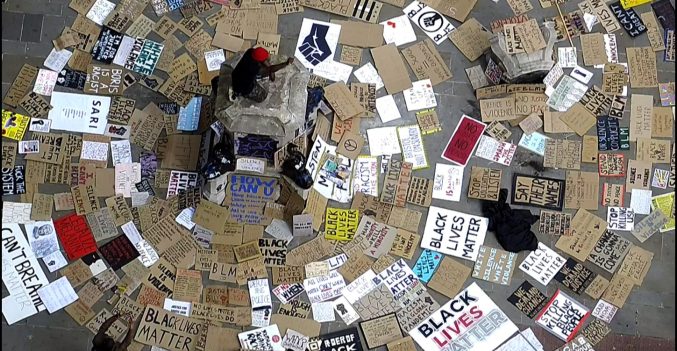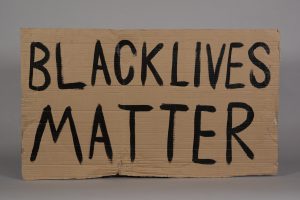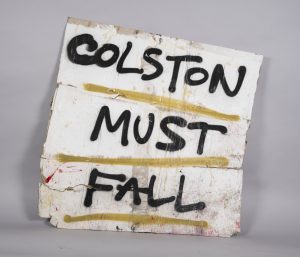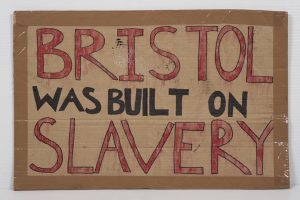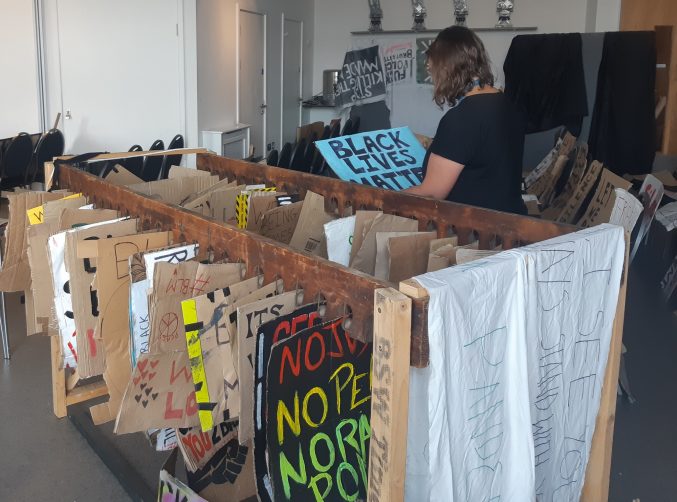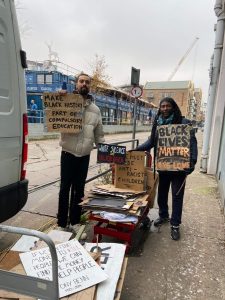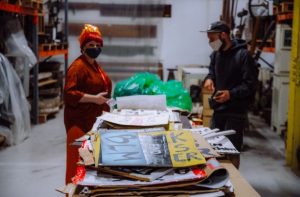Black Lives Matter Placards at Bristol Museums
Posted on by Fay Curtis.
by Amber Druce, Curator of Social History
During protests against police brutality and racial inequality on 7 June 2020, people left placards at the base of the Colston statue plinth. This began before the statue was pulled down and continued afterwards.
The following morning, the placards were carefully collected up by Bristol Waste, on the instruction of the mayor, and a team of four staff from M Shed took them in to the museum. At that time, museums were closed to staff and visitors because of Covid precautions.
There had been some light rain, so we spread them all out in the studio to dry them out and preserve as many as possible. We gave each placard a temporary number, recorded the wording on them, and photographed each one individually. These were used to document them all on our database.
We also received nine placards from Avon & Somerset police, which they had recovered as part of a protest a week later by a group claiming to be protecting the cenotaph. A few placards were also delivered to M Shed anonymously.
In total, there were 568 placards, leaflets, and pieces of fabric from the protests. The Colston statue came in later, after a few days in the harbour, with an attached piece of rope, a bike tyre that became entangled on the statue under water, and an 1895 magazine that was found inside the statue. The latter had the handwritten names of the workmen who fitted the statue in it.
Six of the placards were displayed in a consultation display ‘The Colston statue: what next?‘ in 2021-22, alongside the statue, a timeline, and background information.
The placards have been viewed in storage by thousands of people on store tours, research trips, and filming visits.
64 placards have been added to our social history collection. The selection was based on their local interest, visual impact, current language, and particularly relevant social and political references. Our paper conservator, Ellie, has assessed them. Some of the placards include stains from eggs thrown at the statue, and footprints – both an important part of their story so they won’t be removed. Some of the placards will be used in future displays, and they will be available for researchers to study.
“Protest placards can be difficult to keep in a stable condition – cardboard, for example, is not made for longevity and felt tip pen ink can quickly fade. It’s important however to treat these objects like any other work on paper and to slow down deterioration as much as possible. By storing them in archival boxes, acid free materials and in our environmentally controlled stores the placards will be protected from handling, light, fluctuating humidity and pests.
I’ve carried out ‘first aid’ treatment on some placards, re-adhering detached sheets and creating cushioned supports so they can lie flat in the boxes, however it’s important to keep the works as they were found so dirt, damage and stains need to be stabilised and retained.” – Ellie, paper conservator
We’ve been using some of the other placards as handling objects for museum outreach and learning sessions. We transferred others to New Room Museum and Trinity Centre, where they’ve been used for temporary displays. 100 placards are now with St Pauls Carnival for community outreach projects and for use in the 2023 parade. We can’t wait to see them at carnival.
- Transferring 100 BLM placards to St Pauls Carnival community outreach team in 2022
- Amber Druce (Curator of Social History) & Jamell Ackford (Trinity Centre) in L Shed in 2021. © Khali Ackford
See the BLM placards in the Bristol Museums collection on our online search.
